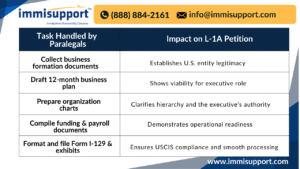
The clock was ticking. A major client was launching their U.S. subsidiary and needed their global COO transferred within 30 days. In the middle of a busy morning at their immigration law firm, attorneys John and Jan discussed the case.
A Conversation Between Two Top Attorneys: John and Jan
John:
“Jan, this L-1A new office case is tight. The client wants their COO in Chicago before the next board meeting. We barely have time to gather all the supporting evidence.”
Jan:
“That’s why I already looped in our immigration paralegal team. They’ve started assembling the org charts, business plan, and lease documents. They’re even drafting the I-129 with the exec summary memo.”
John:
“Impressive. What about proof of business viability?”
Jan:
“Already covered. They pulled bank statements, hiring forecasts, and client leads. Everything’s packaged and ready for premium filing.”
John:
“So we might actually hit the 30-day mark?”
Jan:
“If we file by Friday-and with our paralegals on it-we absolutely will.”
How Immigration Paralegals L‑1A New Office Visa Solutions Save Time and Reduce Risk?
The L‑1A new office visa is ideal for transferring executives to help launch new U.S. operations. But the process is document-heavy, time-sensitive, and requires strategic presentation. Here’s how immigration paralegals streamline it effectively.
1. Assembling USCIS-Ready Documentation Promptly
Immigration paralegals are trained to source and prepare all core documentation needed to satisfy USCIS scrutiny for an L‑1A new office visa.
They gather:
-
Incorporation papers and ownership evidence between entities
-
Executive-level job descriptions and organizational charts
-
Lease agreements and utility setups for U.S. office space
-
Proof of the executive’s employment abroad
-
Pay stubs, tax documents, and benefit records
This helps prevent unnecessary delays or requests for evidence (RFEs).
2. Structuring Evidence of Business Viability
One of the biggest hurdles in an L‑1A new office visa is demonstrating that the U.S. office will grow to support a managerial or executive position.
Paralegals assist by:
-
Drafting 12-month growth plans
-
Compiling bank statements and funding documentation
-
Presenting future hiring projections
-
Gathering contracts with vendors and clients
-
Creating visual timelines of operational expansion
All this helps USCIS see the new U.S. entity as a viable and scalable business.
3. Preparing and Filing the Petition Accurately
Paralegals handle the full assembly and filing workflow with speed and attention to detail.
-
Draft Form I-129 and the L-Supplement
-
Format and paginate all exhibits in USCIS-compliant style
-
Review for inconsistencies across documents
-
Arrange checks and courier delivery for premium processing
-
Monitor receipt and send USCIS updates to the attorney and client
Their precision ensures a clean, fast submission.
4. Creating Workflow Efficiency for Attorneys
Paralegals act as an extension of the legal team by:
-
Keeping clients on task with follow-ups and reminders
-
Reducing the attorney’s workload by 50–70% in document prep
-
Freeing attorneys to focus on strategy, legal analysis, and advocacy
-
Shortening filing timelines from weeks to just a few days
This makes law firms more efficient – and clients more satisfied.
5. Avoiding RFEs and Delays
Well-organized and accurate petitions lower the risk of USCIS sending RFEs, which can add weeks or months to the approval process.
Paralegals mitigate this by:
-
Spotting inconsistencies in job titles and role functions
-
Ensuring all foreign and U.S. entity links are clearly documented
-
Using standard naming conventions and table of contents for exhibits
-
Preparing cover letters that preempt common USCIS concerns
Key paralegal tasks for L‑1A new office visa filings

What Did We Learn?
-
The immigration paralegals L‑1A new office visa strategy is critical for fast, successful executive transfers
-
Paralegals reduce attorney burden, streamline the documentation process, and preempt common USCIS objections
-
Their role includes document gathering, formatting, petition prep, and evidence organization
-
They help law firms meet tight timelines with fewer errors and greater efficiency
What People Are Asking?
1. What specific L‑1A documents do paralegals handle?
Paralegals prepare and organize I-129 forms, business plans, foreign employment records, and all supporting exhibits.
2. Can paralegals communicate directly with clients?
Yes, paralegals often manage client intake, follow-ups, and document collection to keep timelines on track.
3. How do paralegals reduce RFEs?
By ensuring documents are consistent, complete, and in compliance with USCIS formatting and policy guidelines.
4. Are premium processing filings paralegal-friendly?
Absolutely. Paralegals thrive under pressure and ensure filing accuracy to meet premium processing deadlines.
5. Can small firms benefit from outsourced paralegal support?
Yes. Outsourcing paralegal services helps solo and small firms stay competitive without hiring full-time staff.
Disclaimer:
For informational purposes only; not applicable to specific situations.
For tailored support and professional services,
please contact Immisupport, at +1 888 884 2161
Email: info@immisupport.com
Book a Demo: https://immisupport.com/demo
Rated 4.9/5 by immigration attorneys. If you are looking for Outsourcing services for your Immigration practice, please email 📧info@immisupport.com or call 📞(888) 884-2161.
 Book a demo to build your team today
Book a demo to build your team today













 let’s talk - meet with Immigration Outsourcing expert
let’s talk - meet with Immigration Outsourcing expert